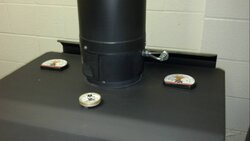Hey all !
Been enjoying my Osburn 2400 EPA Stove !
Thanks for all the helps in replacing the problematic VC stove.
I'm getting 8-10 hour burns - can even forget to get up and still have coal to easily get a fire going hours later. This is really good.
HOWEVER --- Really cold nights or strong wind really gets my draft going. And sometimes if the wood needs a little longer to really catch, sometimes the firing gets really strong and a load of wood can be coals in 3 hours.
I'm talking about Strong Secondary Firing.
So---- on the assumption cutting more air off from getting into the secondary pipes would PROLONG the burn time (even if sacrificing some temp)..... we decided to get a Pipe Damper installed (professionally). It's inserted about 14 inches above the stove top (double walled pipe)
HERES THE STRANGE THING: Closing the damper to 3/4 or a little better OFF actually added 50-75C to the temps and Increased Secondary Firing, and seems to shorten burn time. (and this is always with the front air turned off).
What's up with that? Even the store thought the Damper would restrict the updraft and thus the the Secondary firing--- It's the secondary firing we are trying to minimize.
Thoughts? So we thought, ok, the closed damper is causing more heat to be kept in the stove, increasing the stove Temp and so making the wood burn down faster. But restricted air should reduce the Secondary Firing, but it increased. Not just higher inside temps.
How can this be working backwards ????
Anyone ?
Thanks
Been enjoying my Osburn 2400 EPA Stove !
Thanks for all the helps in replacing the problematic VC stove.
I'm getting 8-10 hour burns - can even forget to get up and still have coal to easily get a fire going hours later. This is really good.
HOWEVER --- Really cold nights or strong wind really gets my draft going. And sometimes if the wood needs a little longer to really catch, sometimes the firing gets really strong and a load of wood can be coals in 3 hours.
I'm talking about Strong Secondary Firing.
So---- on the assumption cutting more air off from getting into the secondary pipes would PROLONG the burn time (even if sacrificing some temp)..... we decided to get a Pipe Damper installed (professionally). It's inserted about 14 inches above the stove top (double walled pipe)
HERES THE STRANGE THING: Closing the damper to 3/4 or a little better OFF actually added 50-75C to the temps and Increased Secondary Firing, and seems to shorten burn time. (and this is always with the front air turned off).
What's up with that? Even the store thought the Damper would restrict the updraft and thus the the Secondary firing--- It's the secondary firing we are trying to minimize.
Thoughts? So we thought, ok, the closed damper is causing more heat to be kept in the stove, increasing the stove Temp and so making the wood burn down faster. But restricted air should reduce the Secondary Firing, but it increased. Not just higher inside temps.
How can this be working backwards ????
Anyone ?
Thanks



